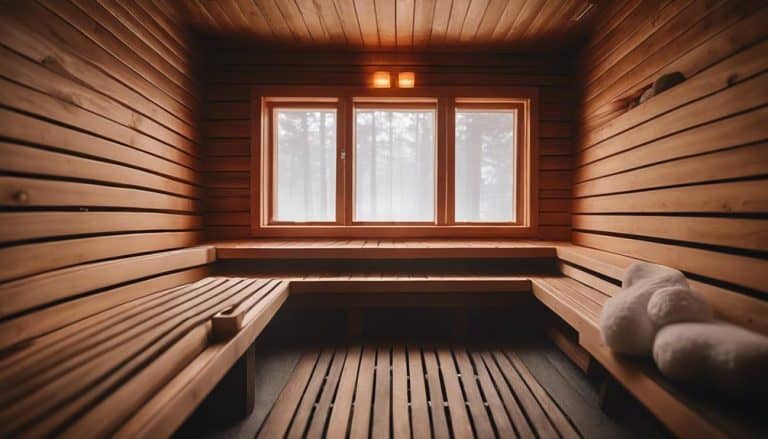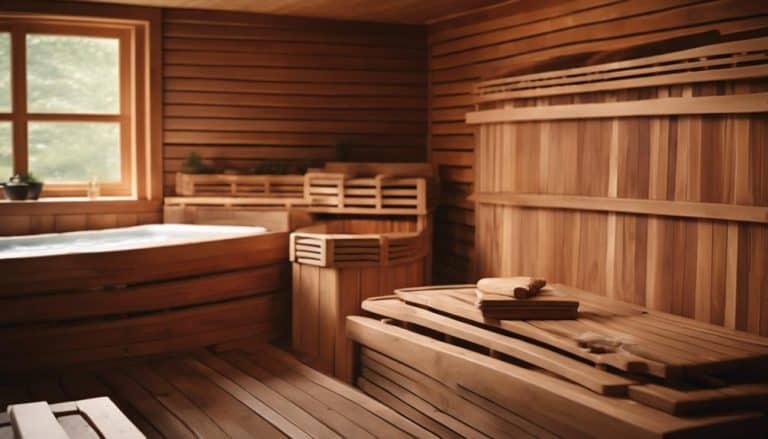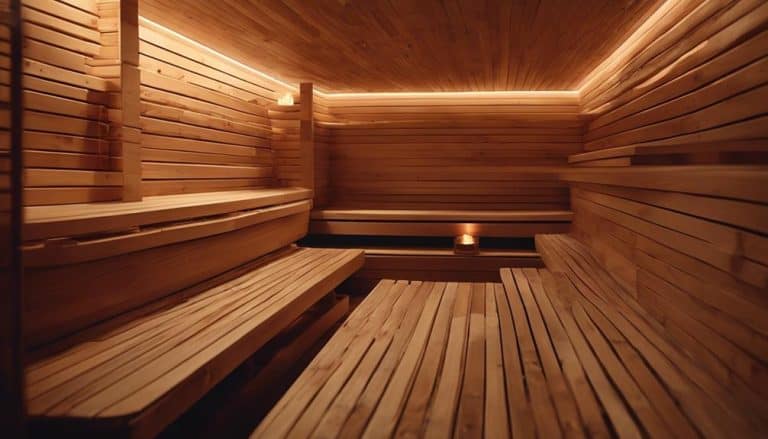Top 10 Differences: Smoke Saunas Versus Infrared Saunas
As someone who has experienced both smoke saunas and infrared saunas, I can confidently say that there are numerous differences between the two. From the distinct heating methods to the unique sauna experiences they offer, smoke saunas and infrared saunas cater to different preferences and needs.
However, what exactly are these differences and how do they impact your sauna experience? In this discussion, we will explore the top 10 disparities between smoke saunas and infrared saunas, covering everything from heating methods and temperature control to health benefits and personal preference.
So, if you're curious to learn more about these fascinating sauna types and how they differ, keep reading!
Key Takeaways
- Smoke saunas offer intense heat and a traditional ambiance, while infrared saunas provide targeted heating and a modern approach.
- Smoke saunas require separate buildings and meticulous temperature regulation, while infrared saunas can be easily installed indoors without extensive construction.
- Smoke saunas have higher initial costs and maintenance needs, while infrared saunas are more cost-effective and require minimal maintenance.
- Smoke saunas are less common and accessible, while infrared saunas are widely available and popular for home use.
Heating Methods
When it comes to heating methods, smoke saunas and infrared saunas offer distinct approaches to creating a relaxing and rejuvenating experience. Traditional smoke saunas are heated by burning wood without a chimney, producing intense heat and a distinct aroma that adds to the cultural immersion. The process of heating a smoke sauna requires patience as it takes longer compared to its infrared counterpart.
On the other hand, infrared saunas utilize infrared light rays to directly heat the body, operating at lower temperatures. This heating method allows for a more targeted approach to raising core body temperature, providing deep relaxation and detoxification benefits.
The intense heat generated by smoke saunas helps to purify the body through profuse sweating. The high temperatures also promote increased blood circulation, aiding in muscle relaxation and pain relief. In contrast, infrared saunas penetrate the skin to raise core body temperature, inducing a similar therapeutic effect but at lower temperatures. This makes infrared saunas a suitable option for individuals who may find the intense heat of smoke saunas overwhelming or uncomfortable.
Both heating methods have their own unique merits. Smoke saunas offer an authentic and culturally immersive experience, allowing individuals to connect with traditional practices. On the other hand, infrared saunas provide direct body heating for therapeutic effects, ensuring a rejuvenating experience at lower temperatures.
Temperature Control

Temperature control plays a crucial role in the sauna experience, and it differs significantly between smoke saunas and infrared saunas. Smoke saunas rely on wood burning without a chimney, resulting in intense heat levels that can reach up to 248°F. In contrast, infrared saunas operate at lower temperatures ranging from 120°F to 140°F, utilizing infrared light waves to directly heat the body.
One of the key differences in temperature control between the two sauna types is the method of heat delivery. Smoke saunas require meticulous temperature regulation to avoid overheating, as the intense heat can become overwhelming. In contrast, infrared saunas offer precise temperature control, allowing users to set their desired heat levels for a more comfortable experience.
Infrared saunas provide a more gentle and consistent heat compared to the fluctuating heat levels in smoke saunas. The infrared light waves penetrate the body, producing a deep heat that's evenly distributed, resulting in a soothing and relaxing sensation. This consistent heat is particularly beneficial for individuals with sensitive skin or those who prefer lower temperatures during their sauna sessions.
Additionally, the temperature regulation in infrared saunas allows for quicker heating times. Unlike smoke saunas that require longer heating times due to wood burning, infrared saunas can heat up quickly, saving both time and energy.
Health Benefits
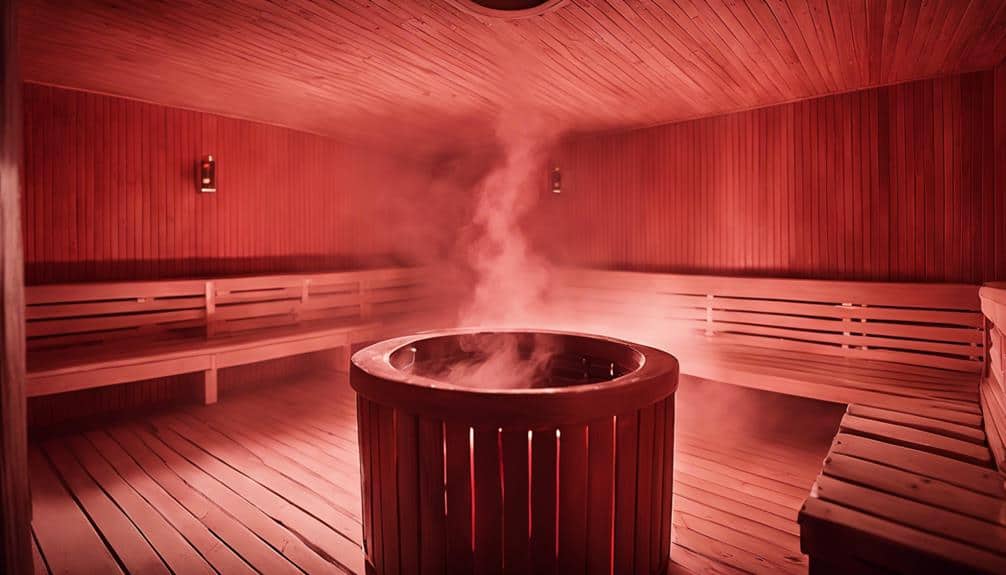
Infrared saunas offer a wide range of health benefits that contribute to overall well-being and relaxation. These saunas use infrared light to heat the body directly, providing a gentle and penetrating heat that aids in various aspects of health. One of the key benefits of infrared saunas is their ability to promote detoxification. As the body sweats, toxins are released, helping to cleanse the body and improve overall health. Additionally, infrared saunas have been found to provide muscle pain relief. The heat therapy from the sauna helps to relax muscles and reduce inflammation, providing relief from soreness and tension.
Moreover, infrared saunas are known to promote relaxation and stress reduction. The heat and warmth of the sauna help to soothe both the body and the mind, allowing for a peaceful and calming experience. Infrared saunas also contribute to skin rejuvenation. The deep heat penetrates the skin, promoting blood circulation and bringing essential nutrients to the surface, resulting in a healthy and radiant complexion.
Sauna Experience

My experience in a smoke sauna was nothing short of invigorating, as the intense heat and aromatic ambiance created a truly authentic and traditional sauna experience. The heat in a smoke sauna is generated by burning wood, which creates a unique atmosphere and a distinct aroma. Unlike modern saunas, smoke saunas lack chimneys, which allows the smoke to fill the room during the heating process. This adds to the overall ambiance and creates a cozy and intimate environment.
In contrast, infrared saunas offer a more modern approach to the sauna experience. Instead of heating the air, infrared saunas use infrared wavelengths to directly heat the body. This mimics the natural heat of the sun without the harmful UV rays, making it a safe and efficient heating method.
One notable difference between smoke saunas and infrared saunas is the heating time. Smoke saunas require a longer heating process as the wood needs time to burn and generate heat. On the other hand, infrared saunas offer quicker heating times, allowing for more convenience and flexibility.
Whether you prefer the traditional and authentic sauna experience of a smoke sauna, or the modern approach of an infrared sauna, both options provide unique benefits and a relaxing sauna experience.
Installation Requirements
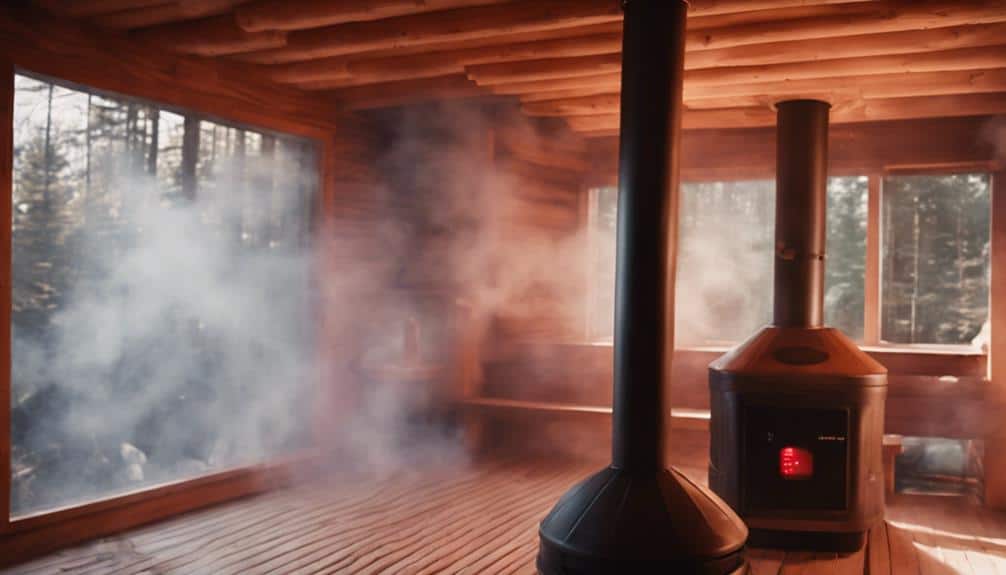
To properly install a smoke sauna, a separate building made of logs is traditionally required. This unique requirement sets smoke saunas apart from infrared saunas, which can be easily installed indoors due to their compact size and electrical requirements.
When it comes to smoke saunas, there are specific installation requirements that need to be considered:
- Ventilation for smoke removal: Smoke saunas rely on wood-burning stoves and produce significant amounts of smoke. Therefore, proper ventilation systems must be in place to ensure the smoke is effectively removed from the sauna building.
- Fire safety considerations: Due to the use of wood-burning stoves, fire safety is of utmost importance in smoke saunas. The installation guidelines for smoke saunas include provisions for fireproof materials, proper insulation, and adherence to local fire codes.
- Logs and construction: Smoke saunas require a separate building, traditionally made of logs, to create the authentic sauna experience. The logs provide excellent insulation and contribute to the overall ambiance of the sauna.
On the other hand, infrared saunas can be set up in existing rooms or spaces with minimal modifications. Their compact size and electrical requirements make them suitable for indoor installation without the need for a separate building or extensive construction. Additionally, since infrared saunas don't produce smoke, ventilation isn't necessary.
Energy Efficiency
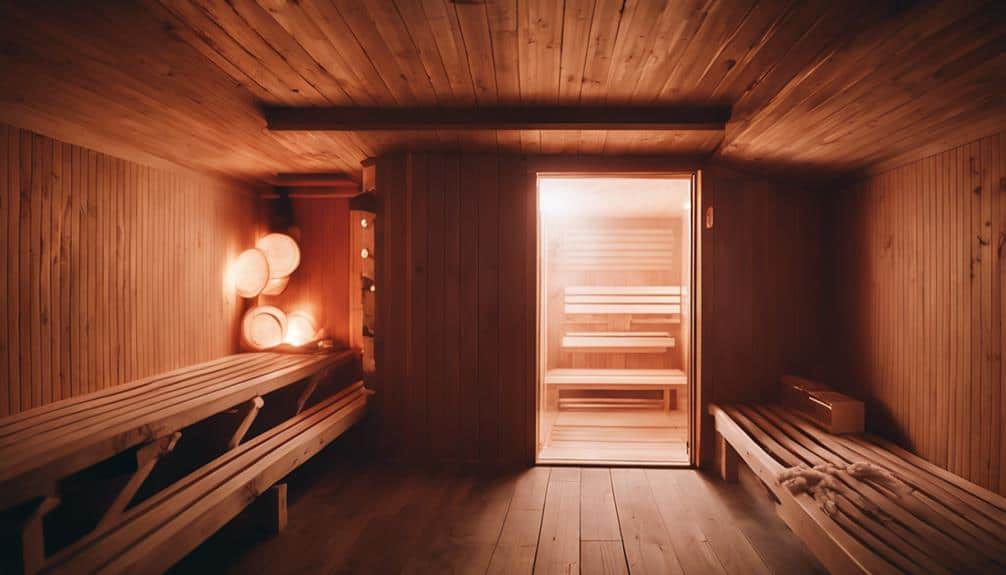
When it comes to energy efficiency, smoke saunas and infrared saunas have distinct differences in their heating methods. Smoke saunas rely on wood combustion and natural heat sources for energy efficiency. However, this traditional heating method requires longer heating times, potentially resulting in higher energy consumption.
On the other hand, infrared saunas use infrared light to directly heat the body, consuming less energy compared to traditional heating methods.
The key to the energy efficiency of infrared saunas lies in their ability to target individuals directly. By heating the body more efficiently, infrared saunas reduce overall energy usage. Additionally, these saunas are designed to minimize heat loss, ensuring optimal energy efficiency during sauna sessions.
In contrast, smoke saunas rely on wood combustion for heat, which can be less efficient compared to the direct body heating of infrared saunas. The longer heating times required by smoke saunas can lead to increased energy consumption. However, it's important to note that the use of natural heat sources in smoke saunas contributes to their energy efficiency.
Cost Comparison

In terms of cost comparison, it's important to consider the initial expenses and long-term operational costs associated with smoke saunas and infrared saunas. Here are some key points to consider:
- Initial Costs: Smoke saunas typically have higher initial costs due to the traditional wood-burning setup. This includes the cost of materials and labor for constructing the sauna.
- Installation and Maintenance: Infrared saunas are generally more cost-effective when it comes to installation and maintenance. They're easier to install and require less maintenance compared to smoke saunas.
- Wood Fuel and Energy Efficiency: Smoke saunas may require additional expenses for wood fuel and maintenance over time. On the other hand, infrared saunas are known for their energy efficiency, resulting in lower long-term operational costs. They use electricity to generate heat, which is more cost-effective than constantly purchasing wood fuel.
Maintenance Needs

Regular maintenance is essential for ensuring the optimal performance and safety of smoke saunas. Unlike infrared saunas, which require minimal maintenance, smoke saunas need regular cleaning due to soot buildup. Since smoke saunas burn wood without a chimney, they produce soot and ash that can accumulate over time. Thorough cleaning is necessary to remove these residues and ensure proper ventilation for the safety of sauna users.
In contrast, infrared saunas have minimal maintenance needs. They don't produce soot or ash, eliminating the need for regular cleaning to remove such residues. Instead, occasional cleaning of the infrared panels is sufficient to maintain their optimal performance.
Maintenance of smoke saunas also involves monitoring fire safety measures. Since these saunas operate by burning wood, it's crucial to ensure that fire safety precautions are in place and regularly checked. Additionally, proper airflow is essential for effective heating in smoke saunas. Regular maintenance includes checking and maintaining the ventilation system to ensure adequate airflow.
Availability and Accessibility

Smoke saunas and infrared saunas differ significantly in terms of their availability and accessibility. Here are the key points to consider:
- Smoke saunas are less commonly found and typically restricted to specific regions in Northern Europe. On the other hand, infrared saunas are more widely available and accessible worldwide.
- Installing and operating smoke saunas can be more challenging compared to infrared saunas. Smoke saunas require specific setups, such as a lack of a chimney for smoke release, which may limit their availability and accessibility in modern settings. In contrast, infrared saunas are easier to install and operate, making them a popular choice for home use.
- Infrared saunas are designed for easy integration into various spaces due to their compact design and straightforward installation process. This enhances their accessibility, allowing individuals to enjoy the benefits of sauna therapy in the comfort of their own homes.
- The accessibility of infrared saunas extends beyond home use. They're also widely available in spas, wellness centers, and even as portable options. This means that individuals who don't have the space or desire to install a sauna in their homes can still access the therapeutic benefits of sauna therapy.
Personal Preference and Comfort
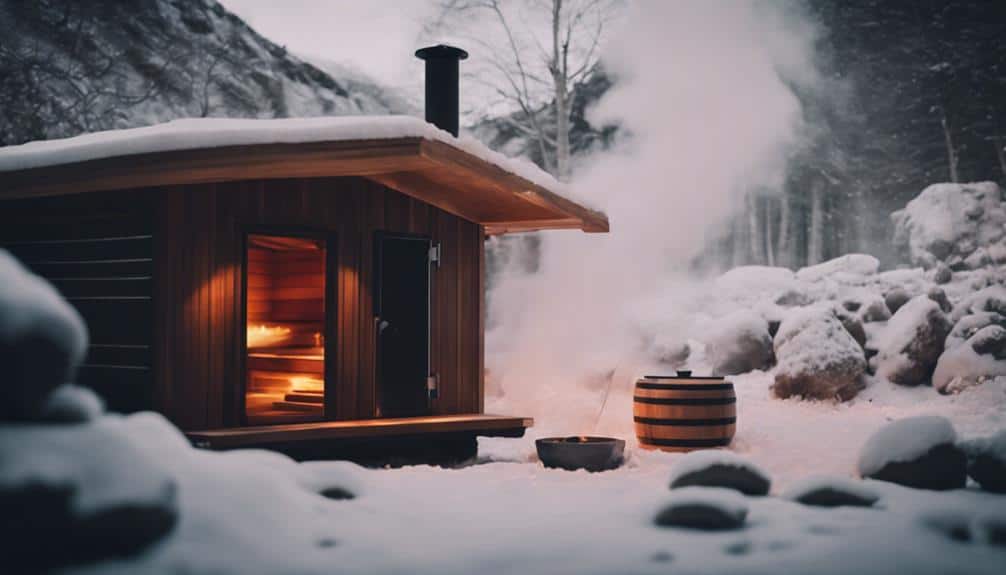
For those seeking a sauna experience tailored to their personal preferences and comfort, the choice between smoke saunas and infrared saunas becomes crucial. Personal preference plays a key role in determining the most suitable option. Comfort levels vary based on individual preferences for heat intensity and humidity.
Some individuals may prefer the intense heat and aroma of smoke saunas, which provide a more traditional experience. The high temperatures and steam generated by the burning wood can create a unique and invigorating atmosphere.
On the other hand, others may opt for the convenience and lower temperatures of infrared saunas. These saunas use infrared heaters to emit radiant heat, which is absorbed by the body to produce a gentle warming sensation. This makes it an ideal choice for those who enjoy a milder heat therapy session.
Understanding your comfort needs and sauna preferences is essential in selecting the most suitable option between smoke saunas and infrared saunas. It's important to consider factors such as desired heat intensity, humidity levels, and the overall ambiance you seek in a sauna experience.
Frequently Asked Questions
What Is the Difference Between the Different Types of Saunas?
The main difference between traditional and modern saunas is the heating method. Traditional saunas, like smoke saunas, use wood-burning systems, while modern saunas, like infrared saunas, use advanced technology to heat the body with infrared light.
What Is Better a Regular Sauna or an Infrared Sauna?
I personally prefer regular saunas over infrared saunas. Regular saunas provide a more intense heat experience, better heat distribution, and rituals like löyly for steam. It's all about personal preference and the overall sauna experience.
What Kind of Sauna Is Best for Detoxification?
For detoxification, infrared saunas are the best choice. They penetrate the skin, raise core body temperature, and promote deep sweating, which aids in toxin release and cleansing.
What Is the Healthiest Type of Sauna?
The healthiest type of sauna is an infrared sauna. It provides numerous benefits for cardiovascular health, respiratory health, skin health, relaxation, stress relief, weight loss, immune system boost, and long-term health effects compared to smoke saunas.
Conclusion
After weighing the various factors, it's clear that both smoke saunas and infrared saunas offer unique advantages. While smoke saunas provide an immersive cultural experience and intense heat, infrared saunas offer accessibility and potential health benefits.
Ultimately, the choice between the two comes down to personal preference and desired sauna experience. So, whether you crave the smoky aroma of burning wood or the gentle warmth of infrared light, there's a sauna out there to suit your needs and provide a truly 'lit' experience.


